Best carbon plate running shoes in 2025
They’ve revolutionised running and are collecting a deluge of world records in their wake. But do you need carbon run shoes? We put them to the test to find out...

Carbon running shoes have become increasingly popular when it comes to choosing the right shoe for race-day and fast efforts. They’ve proven their worth in slashing run times and encouraging a more energy-efficient stride, while their propulsion is often off the charts.
But with great speed comes great price tags to consider. More than any other shoe, you want bang for your buck in a carbon kicker, which is why we’ve laid out our favourites in this article and why we’d recommend them.
But first, you may be wondering just when and how the carbon trend first materialised. Pioneering tri brand Zoot made a carbon running shoe, the Ultra TT 4.0, back in 2014. But it wasn’t until Nike’s Breaking 2 project was launched in 2016 that the carbon super shoe revolution truly began.
In attempting to break the mythical two-hour men’s marathon record, the brand delivered one of the world’s best examples of combining pioneering sporting technological advancements with a marketing bonanza. Adidas, Asics, New Balance, Saucony and more all followed suit, resulting in marathon times plummeting. Elite triathlon is no different today, with athletes tending to opt for carbon-plated shoes to pack the most propulsive punch when it comes to the run leg.
So, while the science and results sing the praises of these supershoes, not all are equal. When choosing your carbon shoe, best to ask yourself what are your race goals and ballpark budget? Navigate to the bottom of this article via the links below for our buying advice. Otherwise, read on for our roundup of the best carbon plate running shoes available right now…
Best carbon plate running shoes at a glance
- Best carbon running shoe: Asics Metaspeed Edge + | Buy now from SportsShoes
- Highly-rated carbon running shoe: Nike Vaporfly 3 | Buy now from Nike
- Best budget-friendly carbon running shoe: Kiprun KD900X | Buy now from Decathlon
- Best money no object shoe: Salomon S/Lab Phantasm 2 | Buy now from Salomon
- Best carbon running shoe for trails: Saucony Endorphin Edge | Buy now from Saucony
Jump to:
- Best carbon plate running shoes
- How we tested
- How do carbon plate running shoes work?
- What technology is used in them?
- Do carbon plate running shoes make a difference?
- Are they against the rules?
- How long do carbon running shoes last for?
- Are there any disadvantages of carbon shoes?
- Are carbon running shoes good for triathlon?
Best carbon plate running shoes
Under Armour Velociti Elite 2

220 Triathlon verdict
Slightly weighty and pricey numbers that struggle against the super shoe contenders. Score: 68%
Pros
- Encourage forefoot strike
- Speedy
Cons
- Weighty
- Big price tag
- £225/$296
The Under Armour Flow Velociti Elite 2 improves on its predecessor with a higher 39.5mm stack, aggressive 2mm drop, and a new full-length carbon plate for enhanced propulsion.
The Warp 2.0 upper is breathable but coarse, making it less suited for sockless triathlon racing. At 260g (UK8), the shoe is heavier than competitors, with noticeable bottom heaviness due to the lightweight upper and dense midsole.
Lacking an outsole, grip is built into the midsole, which raises durability questions but reduces weight (see also the original Flow Velociti Elite). While promising for middle and long-distance races, its performance feels incomplete.
Read our full review of the Under Armour Velociti Elite 2 here and see our list of the best cushioned run shoes for more options.
Saucony Endorphin Edge
Best carbon shoe for trail running

220 Triathlon verdict
A pleasure to run in. Not only fast, but responsive and with great traction. Score : 92%
Pros
- Snappy and propulsive
- Good grip and handles road sections
Cons
- Sizeable price tag
- Some mud ingress
- £200 / $200
The Saucony Endorphin Edge offers speed, responsiveness, and impressive trail performance. Priced at a sizeable £200, it features a carbon fibre plate, paired with PWRRUN PB foam for a smooth, propulsive ride, though initial stiffness may take adjustment.
With a 35mm heel, 29mm forefoot stack, and 6mm drop, it delivers a nimble, neutral ride. Weighing 310g (UK11), it feels light underfoot, while ankle cushioning and secure lacing enhance comfort.
The breathable upper sacrifices some support, but 4mm lugs provide excellent grip on varied terrain, except in extreme mud.
Bonus: gaiter compatibility, toe guard, and recycled materials. A top pick for fast trail running, perhaps not a go-to for slower runs though.
Read our full review of the Saucony Endorphin Edge here.
Nike Zoom Fly 5

220 Triathlon verdict
Potentially a comfy option for long distance, but not one to consider for shorter distances. Score 69%
Pros
- Good stability
- Great as a training shoe
Cons
- Felt heavy
- Not a fast ride
- £164.99 / $217
Nike says that Zoom Fly 5 aims to bridge training and race-day needs, but we found its performance fell short for competitive racing.
At 263g (UK7), it feels heavy and lacks responsiveness, despite the carbon plate. The recycled ZoomX midsole disappoints, offering none of the signature energy return of Nike’s Vaporfly.
On the plus side, the dual-mesh upper provides a true-to-size fit with excellent lockdown and comfort, while the padded heel counter minimizes rubbing.
However, the shoe’s blocky ride and lack of propulsion make it better suited for training runs than race day. Overall, a durable but uninspiring option for serious runners.
Read our full review of the Nike Zoom Fly 5 here.
Salomon S/Lab Phantasm 2
Best money no object shoe

220 Triathlon verdict
Salomon delivers a classy looking race-day shoe that has a competitive weight and is both fast and comfortable. Score: 89%
Pros
- Lightweight and fast ride
- Great stability
Cons
- Not cheap to buy
- Firm ride
- £240 / $315
The Salomon S/Lab Phantasm 2 is a standout race-day running shoe, offering exceptional performance and comfort. Coming in light at just 200g (UK7), its sleek design features a superbly constructed upper with a sock-like fit, seamless tongue, and secure lacing.
A semi-rigid heel counter and suede-like lining enhance comfort, even sockless. A subtle yet practical nod to triathlon race readiness.
The 37mm stack height is lower than counterparts, but still chunky if you’re not used to supershoe geometry. As promised, the PEBA midsole and carbon plate deliver responsive rebound and stability.
Meanwhile, the Contagrip outsole provides excellent traction, and the wider forefoot ensures confidence on corners.
While pricey, ok really pricey, the Phantasm 2 excels across all distances, making it a top choice for racers seeking a lightweight, stable, and high-performing shoe.
Read our full review of the Saucony S/Lab Phantasm 2 here.
Hoka Cielo X1

220 Triathlon verdict
A spongy, springy and slightly bonkers Hoka release that doesn’t seem to have a USP. Score: 70%
Pros
- Propulsive, bouncy ride
- Ideal for distance running and events
Cons
- Heavy and felt unstable
- Not cheap
- Laces were a pain
- £250 / $275
Hoka latest innovation, the Cielo X1, returns with even more stack and cushioning foam.
Once you get the Cielo X1s on, there is Ironman appeal, however, with the layers of PEBA foam delivering arguably the bounciest and spongiest Hoka ride yet.
Frustratingly, the laces don’t stay tied together and whoever designed them should be forced to tie the laces of every Cielo X1 customer stuck at the race start while their rivals are already 500m down the track.
There’s also no tri-friendly heel loop and the narrow opening for the foot also poses problems. Sadly, Hoka’s superior Rocket X 2 also suffer in transition, meaning both of the brand’s super carbon shoes aren’t as tri-friendly as they could be.
Read our full review of the Hoka Cielo X1.
New Balance FuelCell SuperComp Elite v4

220 Triathlon verdict
A pricey sequel but not far off being one of the best race shoes around. Score: 90%
Pros
- Good stability
- Propulsive ride
Cons
- A heavy shoe
- Not cheap to buy
- £260 / $249.99
Aided by the near 40mm stack height (the maximum allowed by governing body World Athletics) and the new FuelCell midsole now made with 100% PEBAX foam, the Elite v4s offer a bouncy run full of energy return.
The shoes felt cushioned, but also stable for such a maximal shoe, and our tester felt confident wearing on moderately twisty tri run courses.
The 4mm heel-to-toe drop and new, thinner and arched carbon plate also encourage race-day use for a wealth of distances and paces.
At £260 ($249.99) and 222g (UK7), they are £40 more expensive and 20g heavier than the previous editions, however, and that extra weight anecdotally felt noticeable when compared to the sub-200g club of the Asics Metaspeed Edge+ and Nike Zoomx Vaporfly 3, for example.
Read our full review of New Balance FuelCell SuperComp Elite v4.
Craft Nordlite Speed

220 Triathlon verdict
If you like firm and rigid this could be the shoe for you, beware of the stitching above the heel counter if running sockless. Score: 79%
Pros
- Comfortable and supportive insole
- Ideal for those seeking a firmer ride
Cons
- A lack of bounce and propulsion
- Not suited to faster runs
- £185 / $220
Craft’s Nordlite Speed carbon plated road shoe has a built-in Ortholite insole which gives the shoe a lovely initial soft feel, but our tester found that it quickly dissipated while running, leaving the Nordlite Speed’s ride feeling firm
The upper of the Nordlite Speed is completely unstructured. The material is a very thin, ventilated synthetic mesh, so it scores highly for breathability.
The lack of structure in the upper didn’t cause problems during testing, though, and the shoe felt very stable for its lack of upper and relatively high stack (40mm heel/32mm forefoot).
Read our full review of the Craft Nordlite Speed.
Brooks Hyperion Max 2

220 Triathlon verdict
A great training contender at a relatively decent price. And these can handle racing too. Score: 84%
Pros
- Decent value for money
- High levels of comfort
Cons
- Not the lightest
- Can feel a little firm
- £160 / $180
Brooks Hyperion Max 2’s shine on faster-paced training efforts, with the shoe’s innovative SpeedVault plate offering the pop strangely absent in the Hyperion Elite 3, but with enough support and stability for midtempo efforts.
Despite the ‘Max’ in the title and the 36mm heel height, there’s a firmness here that means these wouldn’t be our pick for easy recovery plods.
Overall, though, these are a brilliant neutral shoe that straddle the training and racing genres and a timely return to form for Brooks.
Read our full review of Brooks Hyperion Max 2.
Saucony Kinvara Pro

220 Triathlon verdict
A reasonable choice if you want supershoe-like stiffness in training. Score: 76%
Pros
- Support
- Good traction in the wet
Cons
- Unsuitable for racing
- Not cheap to buy
- £200 / $250
Saucony continues to innovate with these chunky carbon-plated running shoes.
Our tester found the Kinvara Pro a strange offering. It’s a carbon-plated trainer with a stack height of 42mm, which means it can’t be used in competition, if you had wanted to. It’s also £200, which is a hefty stack of money to pay for a shoe you can’t use for racing.
The upper hugged the feet nicely and felt breathable, while the cushioned ankle collar and tongue offered high levels of comfort.
The outsole also delivered good traction both on wet and dry pavement and doesn’t collect stones, but the treat pattern might not prove to be durable over the long term.
Read our full review of the Saucony Kinvara Pro.
Asics Metaspeed Edge +
Best carbon running shoe
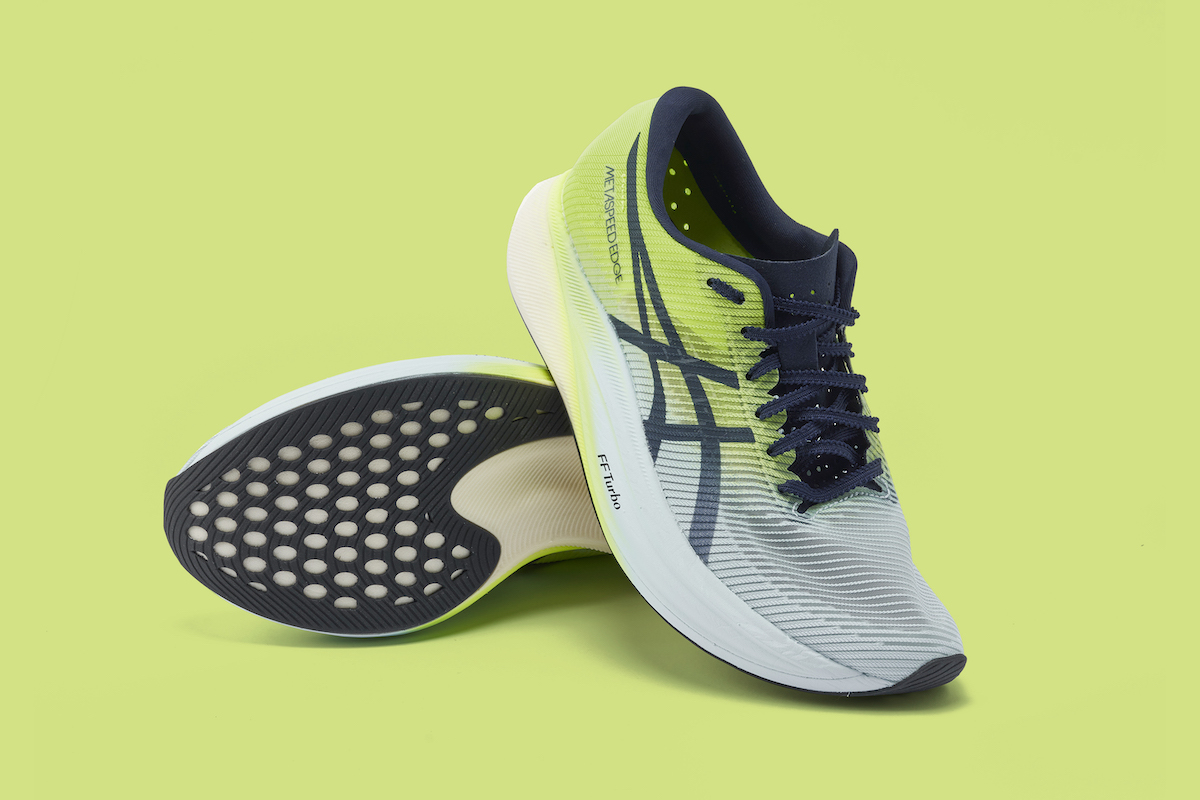
220 Triathlon verdict
Durability concerns aside, this is a lean, stylish shoe that is well-suited to speedy runners. Score: 88%
Pros
- Impressively lightweight
- Nimble, propulsive feel
Cons
- Question mark over durability
- May not be stable enough if you pronate inwards
- £225 / $250
The Metaspeed range comes in two different styles – the Edge +, on test here, which is tailored to athletes that increase cadence when running faster, and the Sky +, which is designed for runners that increase their stride.
Right from the very start we found the Edge + to look and feel amazing. The brand’s FFBlast Turbo foam makes up most of the midsole, which Asics says is 50% lighter than EVA foam. Total weight for this UK size 7 is an impressive 194g.
We enjoyed the combination of bounce and ground feel, while the nimbleness and traction on offer were also welcome.
Despite being lithe in its construction, the tongue provided ample comfort for long efforts, while the upper proved breathable enough on balmy days.
One thing we would note, though, is that there are already signs of wear on the outsole.
See our full Asics Metaspeed Edge + review for more.
On Cloudboom Echo 3
- Buy now for men from Runner’s Need (£212)
- Buy now for women from Runners Need (£212)
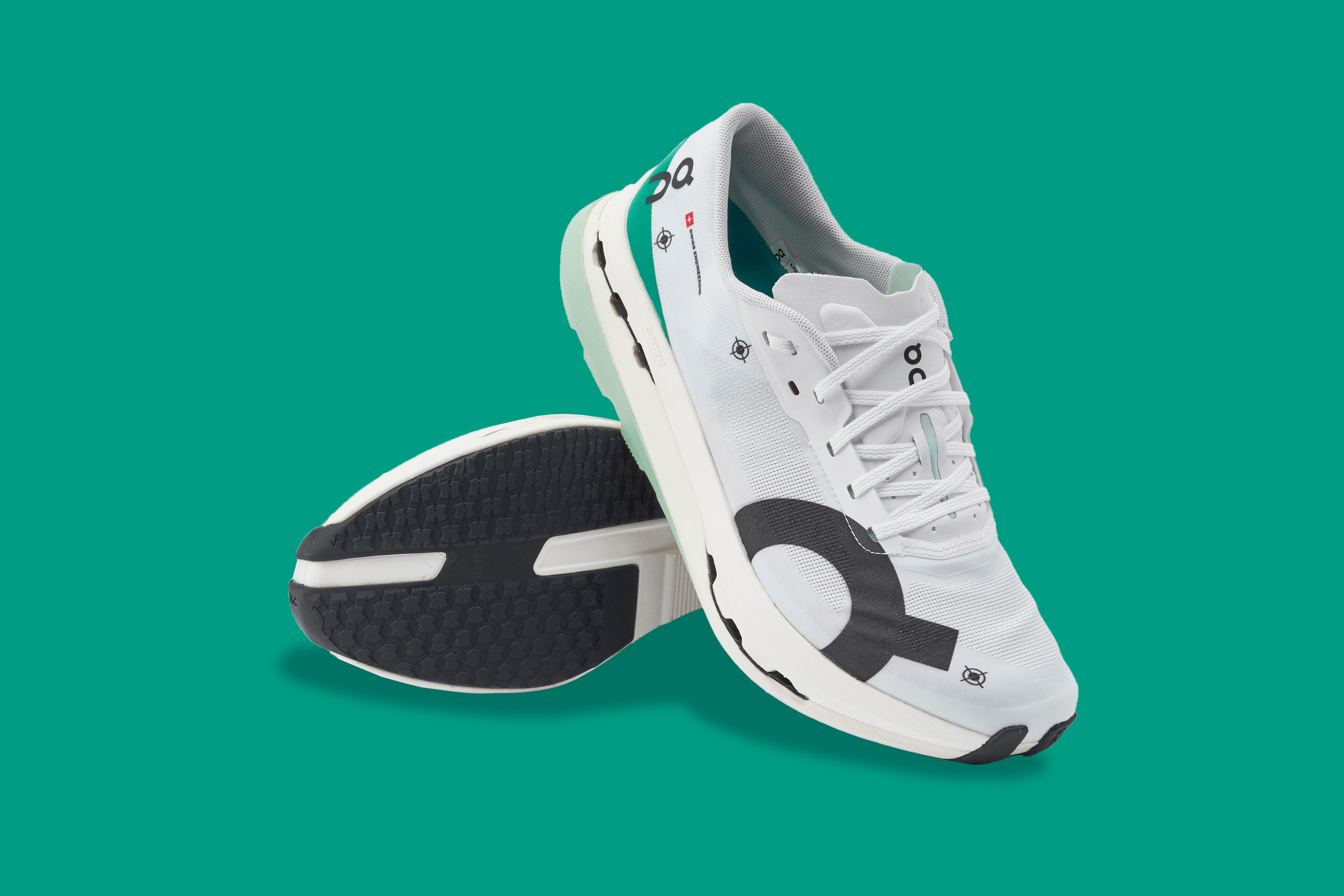
220 Triathlon verdict
Durable and suited to triathlon racing in many aspects, but slightly firm and likely to prove divisive. Score: 75%
Pros
- Very lightweight
- Grippy and durable
Cons
- Firmer than others
- Narrow fit and lack of stability won’t suit everyone
- £260 / $289.99
One of the first things you notice about the Cloudboom Echo 3 is that it’s a pretty lightweight shoe, weighing 211g per shoe in a UK size 7.
Inside the shoe you’ll find a full-length carbon plate sandwiched between two layers of foam, which ultimately results in a snappy, propulsive ride.
That said, they do feel firmer than some other options here, while a 10mm heel-to-toe drop saw us switch to heel striking.
Fit is slightly narrower than some competitors also on test and, though nimble, they’re not the most supportive.
On the flip side, the upper is incredibly breathable, fits securely and contributes to a decent sockless running experience – key for many triathletes on race day.
The durability of the outsole is also impressive, as is its grip, however, this reviewer did experience some knee troubles during testing.
Read our full On Cloudboom Echo 3 review for more.
New Balance FuelCell SC Elite V3
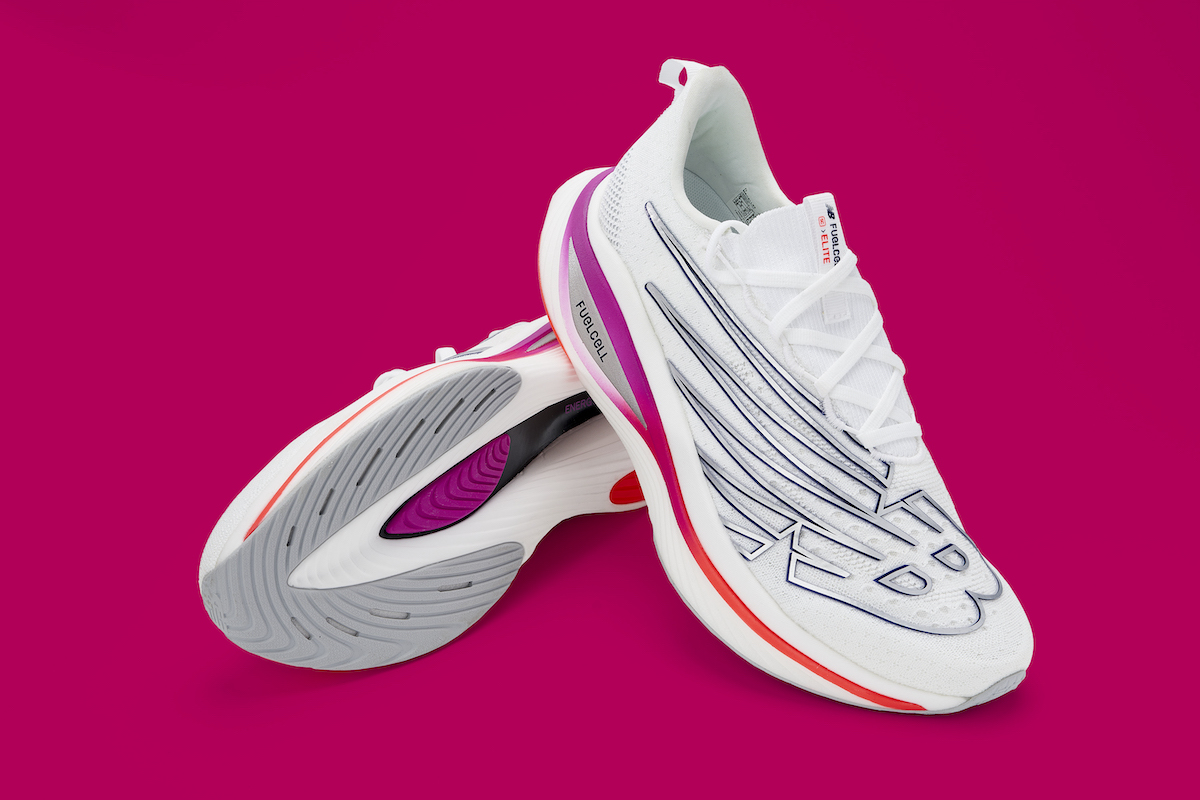
220 Triathlon verdict
If you want a carbon plate running shoe for triathlon, it’d be hard to look past this offering from New Balance. Score: 91%
Pros
- Heel and tongue loops handy for triathlon
- Very comfortable
Cons
- 40mm stack may be too high for some
- Fit is slightly snug
- £220 / $225
With both heel and tongue loops, this shoe from New Balance is particularly transition-friendly for triathletes.
Better yet, the built-in fabric tongue and mesh upper offer impressive levels of comfort for sockless running.
But how’s the ride? Well that’s pretty good, too, with the 4mm drop encouraging a forefoot strike and a full-length carbon plate delivering an ideal amount of propulsion.
Underfoot, the 40mm stack height helps provide a decent amount of comfort, making these well suited for longer distances.
That said, they also feel both nimble and stable enough for shorter city courses, while a weight of 208g per shoe (UK7) is also welcome.
See our full New Balance FuelCell SC Elite V3 for more.
Nike Vaporfly 3
Highly-rated carbon running shoe
- Buy now for men from Nike (£239.99)
- Buy now for women from Nike (£239.99)

220 Triathlon verdict
A fantastic carbon plate running shoe, but one that may not tick all the boxes for triathletes. Score: 85%
Pros
- One of the lightest carbon shoes on the market
- Brilliant ride combines speed, bounce and stability
Cons
- High price tag
- Tongue and upper not the most comfortable
- £234.95 / $260
The OG of super shoes is back, but is it back with a bang? Well triathlete Sam Laidlow would argue so, given his impressive performance at the 2022 Ironman World Championship, where he finished second.
The shoe comes with a full-length carbon plate and an impressively low weight of just 183g (per shoe, UK7). That’s complimented by an 8mm heel-to-toe drop.
As a result, the ride is a combination of speed, bounce and stability, striking of a fine balance between spongy and firm.
That’s all well and good, and makes the Vaporfly well suited to a range of distances, but it does lack a few features that’d be high on a triathlete’s wish list.
Namely, the tongue needs a bit of tinkering with to hit the sweet spot and the mesh upper lacks adequate comfort for going long without socks. That said, the latter does offer a decent amount of ventilation.
With socks, comfort is high, with the cushioned heel collar particularly helpful for keeping the foot in place.
Read our full Nike Vaporfly 3 review for more.
Brooks Hyperion Elite 3
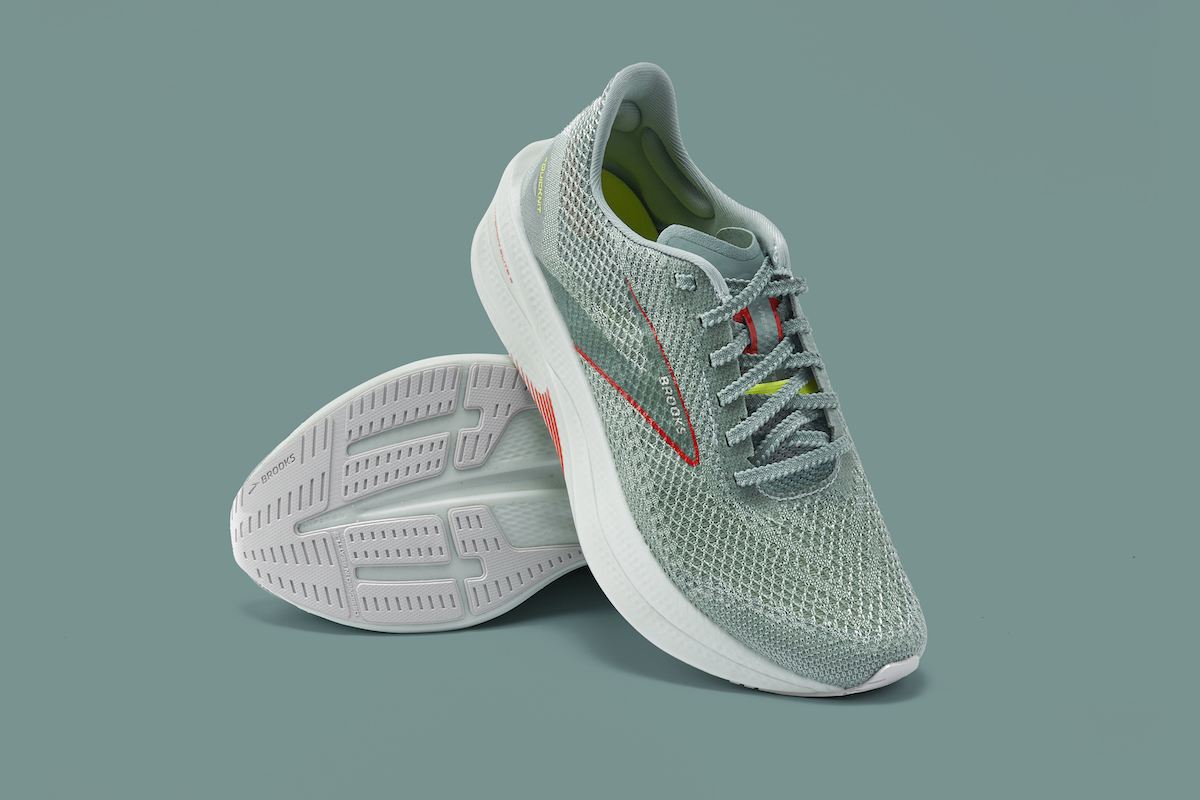
220 Triathlon verdict
Like the colour scheme, there’s not too much here to get excited about. Score: 68%
Pros
- Lots of stability
- Comfortable and stable upper
Cons
- Lack of propulsion
- Firm ride
- £200 / $250
Brooks was slow to the maximal shoe party and, based on the brand’s unisex Hyperion Elite, is still yet to make a carbon super shoe.
There’s no sign of PEBA-style foam here and it instantly shows with a lack of propulsion on the run and a far firmer ride than all bar the Kiprun here.
It’s a very stable ride, so we had little fear of turning our ankle in these, while the rigid tabs on the outsole give added durability.
The QuicKnit upper is the main upgrade from V2 and it’s great, proving breathable and supportive during June’s heatwave.
The coarse nature isn’t for sockless racing, though, and that comment could apply to the 225g Hyperions overall (the joint heaviest pumps on test).
We’d wear them for mid-tempo training runs, but there are plenty of shoes that can do that at half the price.
Under Armour Velociti Elite

220 Triathlon verdict
Lightweight if pricey carbon racers with plenty of tri appeal. Score: 84%
Pros
- Comfortable and nimble ride
- Breathable upper
Cons
- Cost feels a little high
- Not as propulsive as some competitors
- £225 / $250
The new unisex Flow Velociti Elite up the ante of Under Armour’s £140 Flow Velociti 2s by, yep, inserting a carbon foot plate into the midsole.
The run feel is measured and comfortable, and there’s no breaking-in process. A Carbon Lite if you will, which acts as a smooth intro to the genre but does feel less aggressively fast than some here.
That’s not to say they’re not peppy, and they consistently promote an uptempo forefoot running experience.
They’re nimble on the twists of a multisport run course and they retain the tri friendliness of the Velociti 2s with a breathable mesh upper and sockless comfort.
They’re also lighter, coming in at 218g (UK7) compared to the Velociti 2’s 236g.
That plate has added over £80, however, so whether you make the jump will depend on your bank account.
Hoka Rocket X 2
Buy now from Hoka (£220)

220 Triathlon verdict
A brilliant shoe for runners in the dry, but less suited to T2. Score: 84%
Pros
- Bouncy, propulsive ride
- Good ground feel
Cons
- Heel counter can collapse when putting on in a hurry
- Tongue takes some time to sit right
- £220 / $250
The Rocket X 2 is a complete transformation of the previous Rocket X – considerably more expensive, propulsive and successful.
The stack height has increased by 6mm to 36mm (the heel-to-toe drop is 5mm) due to the PEBA midsole foam replacing the previous version’s compression-molded EVA foam.
The result is a bouncier, more propulsive ride, but with enough feel for the asphalt.
That foam adds some weight (236g compared to 210g), but Hoka has helped reduce this via the limited outsole grip (wet cobbles beware!) and a paper-thin upper that’s tougher than it looks securely holding the foot and minimising rubbing from internal seams.
Even with elastic laces, though, the they suffer in T2, the lithe heel counter often collapsing and the gusset/tongue taking some fiddling to sit flush.
Kiprun KD900X
Best budget-friendly carbon running shoe

220 Triathlon verdict
A decent carbon debut offering value and durability in equal measure. See our full Kiprun KD900X review for more. Score: 82%
Pros
- Incredible value
- Warranty is appreciated
Cons
- Super stiff sole means a muted run experience
- Tongue takes time to line up
- £129.99
Despite being half the price of pretty much every competitor on the market, Decathlon’s KD900X has enough positives to make them a decent contender in the carbon run shoe sphere.
There’s a wide toe box and roomy upper, but we found the edges of the minimalist tongue tricky to line up. Though the latter does contribute to the shoe’s 225g weight (UK7).
The sheer stiffness of the sole and full-length carbon plate offers little give and creates a slightly muted running experience.
That said, they do deliver a welcome dose of forward propulsion, which is helped by an 8mm heel-to-toe drop,.
There’s a decent 1,000km warranty and, while we wouldn’t call the upper top, top quality, they perform when navigating technical courses laced with corners.
Saucony Endorphin Elite
Buy now from SportsShoes (£279.99)
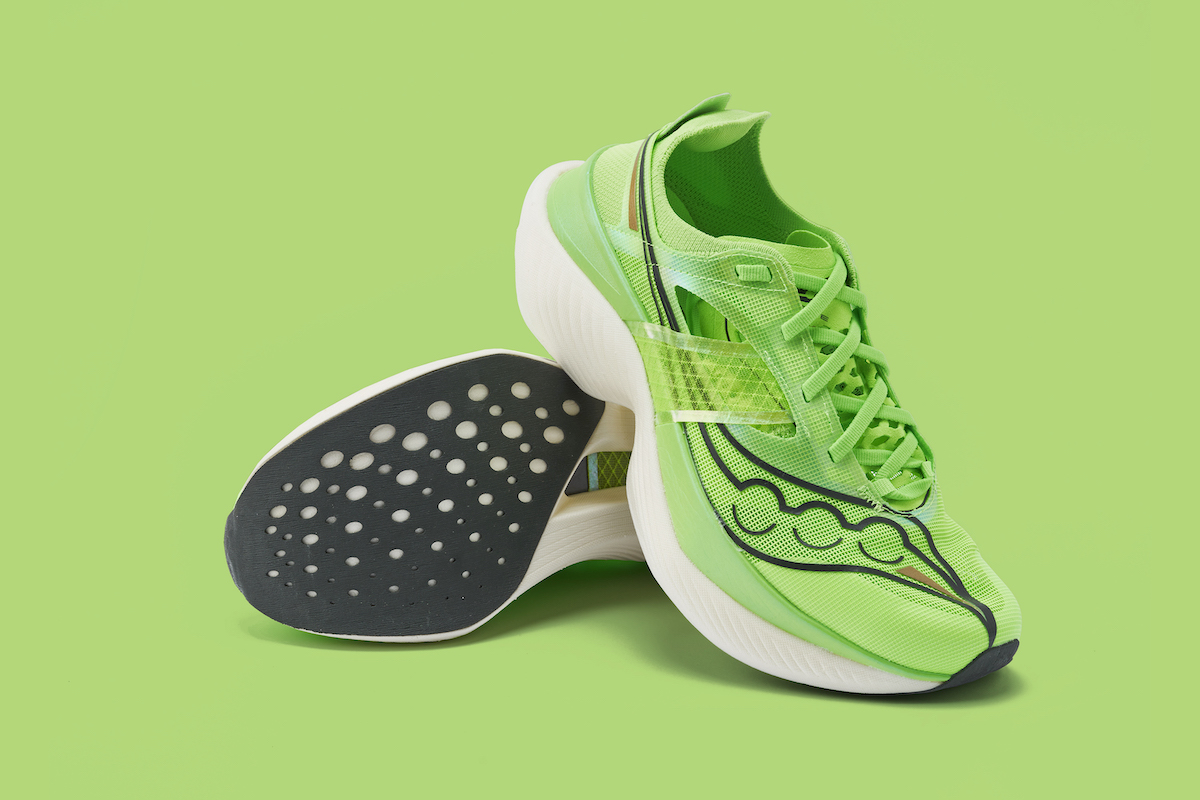
220 Triathlon verdict
Concerns about durability, but other wise this is a speedy, stable shoe that is a lot of fun to run in. Score: 83%
Pros
- Very lightweight shoe
- Ride is responsive and propulsive
Cons
- Very high price tag
- Durability concerns
- £280 / $275
The Endorphin Elite’s 39.5mm wedge of PRRRUN HG foam, 189g weight and carbon plate all combine here to deliver a responsive, enjoyable and swift ride.
As you can see in the image above, the mesh upper is lightweight and barely there in places, which helps with breathability, however it’s not the most comfortable for running without socks in a triathlon.
They’re not the quickest to pull on either, with the heel counter occasionally collapsing when rushing to get your feet in them. When they are on, they aren’t quite as secure as we’d like them to be, either.
Worryingly given the £280 price tag, there’s already signs of wear on the outsole.
Otherwise, this is a quick, supportive shoe.
See our full Saucony Endorphin Elite review for more.
How we tested
Each of the carbon plate running shoes featured here have been personally tested by our team of expert gear testers, who have been taking part in triathlon and running events for a combined total of 30 years.
Every shoe is rigorously tested over a series of runs, covering distances from 5k to long-distance runs, such as half-marathons and marathons.
Our testing took place against a set of criteria that includes comfort, propulsion, weight, support, grip and durability.
We typically take test shoes on the same routes, with similar levels of training readiness, so we can compare run times.
Any shoe that has scored above 90% is genuinely class-leading. Those that score between 80-90% are still among the best, while those from 70-80% are decent performers, but have one or two issues holding them back from top marks.
How do carbon plate running shoes work?
The major aim of carbon run shoes is to improve the running economy of an athlete, allowing you to move faster and more efficiently, while at the same time using less energy.
The trainer’s carbon plate should produce a spring-like effect that minimises the energy needed to propel from the tarmac with each stride.
If having a carbon plate in the shoe sounds like it could produce a harsh and rigid runner akin to running in bike shoes, the slab of midsole foam softens the ride and reduces the metabolic cost to the runner, while also increasing the responsiveness and energy return of a shoe.
This increase in cushioning should increase the shock-absorbing aspects of the shoe, which in turn should lower the chance of muscular damage, especially handy for long-distance triathletes facing the demands of a half or full marathon after the swim and bike legs, and also anyone wanting to train day after day.
What technology is used in them?
Whereas a decade ago racing shoes were once stripped-back flats with minimal midsoles, now oversized (or maximal) footwear reigns supreme.
The influence of Hoka and, more latterly, Nike looms large in the carbon shoe world, with the stack height limit of 40mm (see right) meaning a lot of foam is being utilised.
A feature of the Nike Alphafly and Vaporfly, Asics Metaspeed Sky and more, PEBAX is the poster child of 2023’s foam world, and has proven to be the foam with the most energy return.
It’s also reported to be the lightest, allowing brands to create those 40mm-deep wedges of foam without adding huge weight, while it doesn’t adjust to temperature changes like some TPU-based midsoles can.
Do carbon running shoes make a difference?
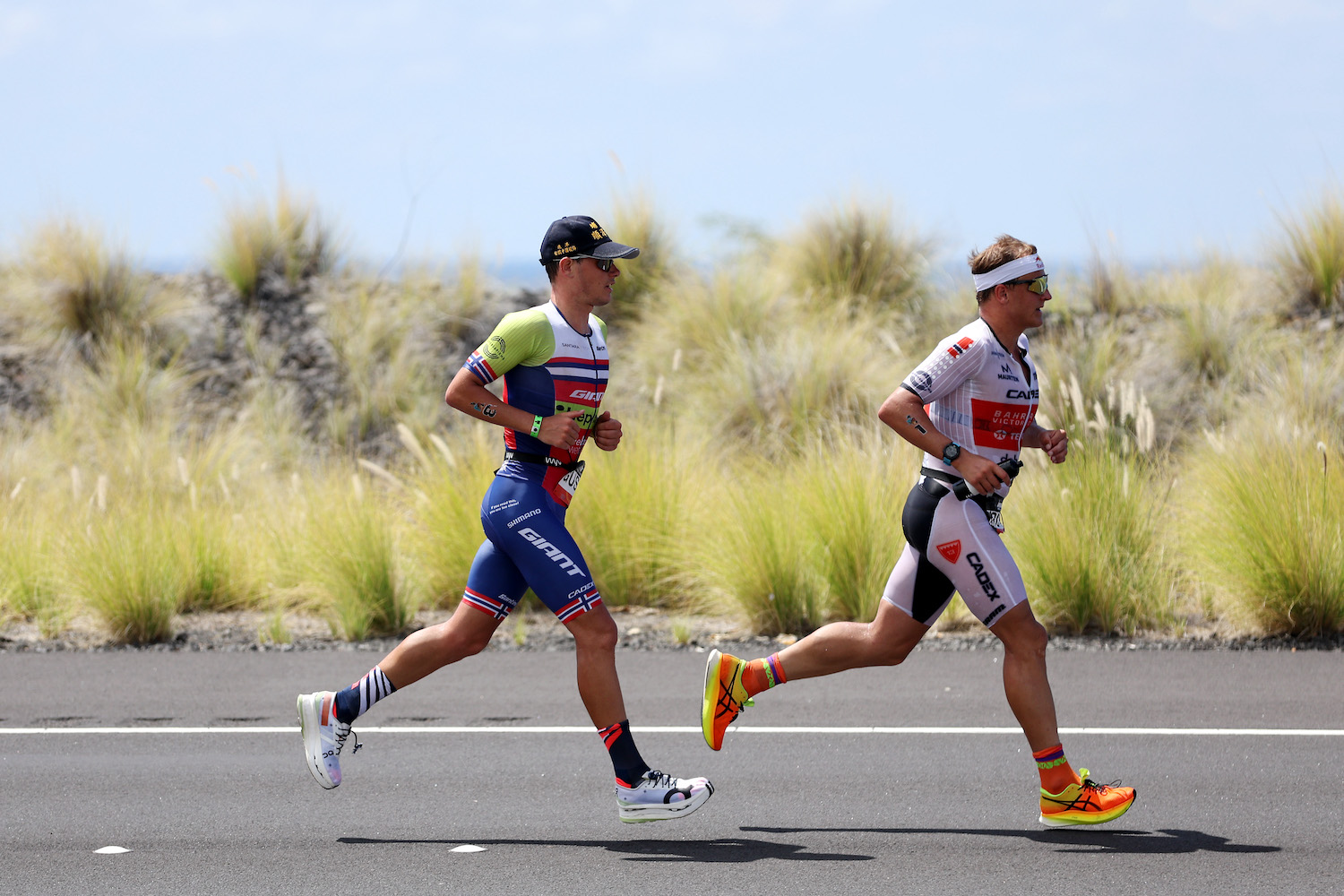
The Nike Vaporfly 4% proudly states the benefits to runners in its title, with studies showing that running economy improved by 4% when wearing the carbon-plated shoe.
And it’s not just elite runners who’ll benefit from the propulsion gains, with runners in the 3:30 to 4hr range seeing marathon times cut by around five minutes, potentially a decisive amount if you’re chasing PBs or age-group honours.
Those gains, of course, come at a fiscal cost, with just one shoe on test here below £200.
There’s also the argument that the level playing field of running has evaporated in this technological revolution, the purity trampled by a taut carbon strip wrapped in a chunky wedge of PEBAX. But that’s an argument for another time…
Are they against the rules in races?
Carbon-plate running shoes all sit around the 30-40mm stack height, which is a lot of foam/shoe.
While the heel-to-toe drop is usually fairly minimal (around 5mm), if you’ve become used to wearing minimal shoes or like to feel the ground when road running, there’s a certain amount of numbness when striding out in carbon super shoes.
The maximum height for a shoe stack, as set by World Athletics (and inherited by World Triathlon), is that 40mm mark. Any higher and stability issues will be heightened to excessive levels.
How long do carbon running shoes last for?
The research on the longevity of carbon super shoes isn’t conclusive, but anecdotally we have worries.
Our doubts stem from how long that carbon plate maintains its taut propulsiveness and, moving to the outsole, how long the minimal tread lasts before wearing away.
The latter is where brands look to reduce weight, meaning that some of these shoes lack wet weather grip, too.
Are there any disadvantages of carbon shoes?

Besides the concerns around durability, the carbon plate is rigid and can lead to a lack of bend in the shoe and an unforgiving ride, resulting in added strain and the chance of injury.
That being said, the current crop have largely improved this via the forgiving midsole foam.
Are carbon running shoes good for triathlon?
While many of the carbon shoes here have proven themselves on marathon road-running courses, the unique nature of tri place additional and myriad demands on them.
The performance in the bike-to-run transition is one of the biggest variables to consider, with many shoes boasting featherweight tongues and lithe heel counters, which are ideal for lowering the shoe’s weight, but can take plenty of time to align with the foot or can crumble on impact with the heel, respectively.
You’re also likely to be putting sweaty post-bike feet into the shoe as well, so look at how efficient the aeration is, and take their ability to be worn sockless into account if you prefer to run without socks.
Triathlon running courses, especially short-course city-centre ones, can also be tight and twisting multi-lap affairs instead of the point-to-point nature of standalone marathons, so look at how well the shoe can navigate changes in direction.
Value and aesthetics, weight and durability have also been considered here; the top pumps being those that tick the boxes for the all-important tri race day.




